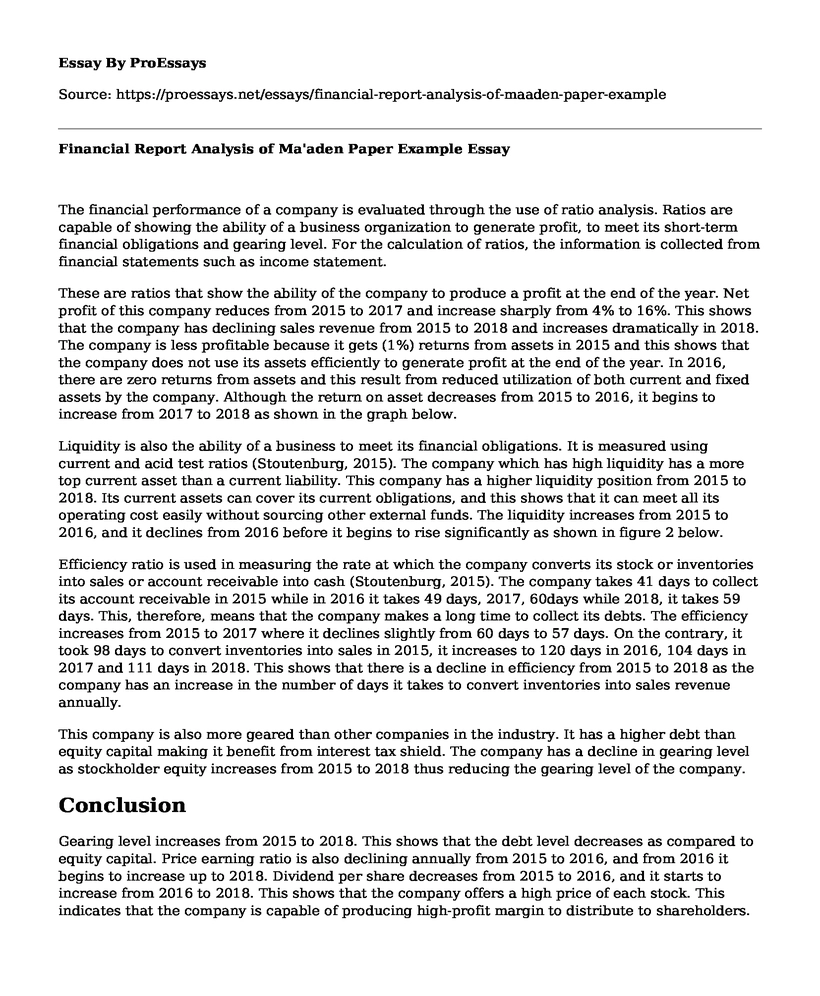The financial performance of a company is evaluated through the use of ratio analysis. Ratios are capable of showing the ability of a business organization to generate profit, to meet its short-term financial obligations and gearing level. For the calculation of ratios, the information is collected from financial statements such as income statement.
These are ratios that show the ability of the company to produce a profit at the end of the year. Net profit of this company reduces from 2015 to 2017 and increase sharply from 4% to 16%. This shows that the company has declining sales revenue from 2015 to 2018 and increases dramatically in 2018. The company is less profitable because it gets (1%) returns from assets in 2015 and this shows that the company does not use its assets efficiently to generate profit at the end of the year. In 2016, there are zero returns from assets and this result from reduced utilization of both current and fixed assets by the company. Although the return on asset decreases from 2015 to 2016, it begins to increase from 2017 to 2018 as shown in the graph below.
Liquidity is also the ability of a business to meet its financial obligations. It is measured using current and acid test ratios (Stoutenburg, 2015). The company which has high liquidity has a more top current asset than a current liability. This company has a higher liquidity position from 2015 to 2018. Its current assets can cover its current obligations, and this shows that it can meet all its operating cost easily without sourcing other external funds. The liquidity increases from 2015 to 2016, and it declines from 2016 before it begins to rise significantly as shown in figure 2 below.
Efficiency ratio is used in measuring the rate at which the company converts its stock or inventories into sales or account receivable into cash (Stoutenburg, 2015). The company takes 41 days to collect its account receivable in 2015 while in 2016 it takes 49 days, 2017, 60days while 2018, it takes 59 days. This, therefore, means that the company makes a long time to collect its debts. The efficiency increases from 2015 to 2017 where it declines slightly from 60 days to 57 days. On the contrary, it took 98 days to convert inventories into sales in 2015, it increases to 120 days in 2016, 104 days in 2017 and 111 days in 2018. This shows that there is a decline in efficiency from 2015 to 2018 as the company has an increase in the number of days it takes to convert inventories into sales revenue annually.
This company is also more geared than other companies in the industry. It has a higher debt than equity capital making it benefit from interest tax shield. The company has a decline in gearing level as stockholder equity increases from 2015 to 2018 thus reducing the gearing level of the company.
Conclusion
Gearing level increases from 2015 to 2018. This shows that the debt level decreases as compared to equity capital. Price earning ratio is also declining annually from 2015 to 2016, and from 2016 it begins to increase up to 2018. Dividend per share decreases from 2015 to 2016, and it starts to increase from 2016 to 2018. This shows that the company offers a high price of each stock. This indicates that the company is capable of producing high-profit margin to distribute to shareholders.
References
Stoutenburg, G. (2015). Vicious Regresses, Conceptual Analysis, and Strong Awareness Internalism. Ratio, 29(2), 115-129. doi:10.1111/rati.12087
Cite this page
Financial Report Analysis of Ma'aden Paper Example. (2022, Dec 04). Retrieved from https://proessays.net/essays/financial-report-analysis-of-maaden-paper-example
If you are the original author of this essay and no longer wish to have it published on the ProEssays website, please click below to request its removal:
- Deductions and Losses: Certain Itemized Deductions
- Republican Tax Plan Essay
- Should We Use Credit Cards? - Research Paper
- Paper Example on TAM's Growth: From $1M to $25M in 2009 Under Jack's Management
- IMF & WB: Criticisms & Conditionality Policy - Essay Sample
- Essay Sample on Unlock the Benefits of Bitcoin: Digital Cryptocurrency without Banks
- Essay Sample on Efficient Tech Practices: Key to Business Success in the Digital Age







